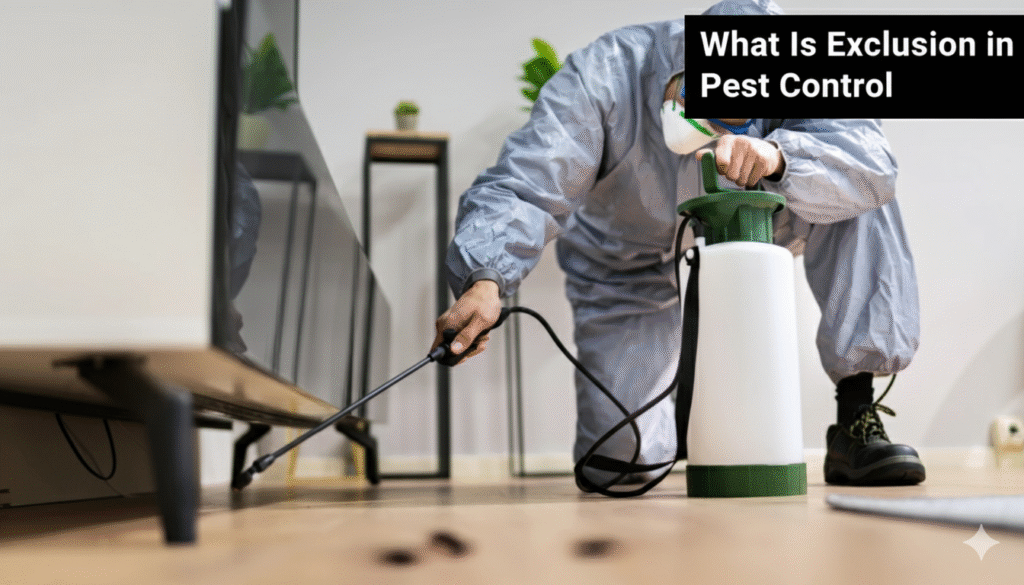Pests are more than just a nuisance; they can cause significant damage to property and even pose health risks. Whether it’s rodents gnawing through your wires or termites silently eating away at your foundation, pest problems can quickly escalate if not addressed. While chemical treatments and extermination methods may seem like the go-to solutions, there’s another powerful, proactive approach to pest control: exclusion.
But what exactly is exclusion in pest control, and why is it so important? Let’s take a deeper dive into this strategy and why it should be a key component of your pest management plan.
What Is Pest Exclusion?
At its core, pest exclusion is a prevention-focused strategy aimed at keeping pests out of your home or business. Unlike reactive pest control methods, which focus on eliminating pests after an infestation occurs, exclusion takes a proactive approach by blocking entry points and creating barriers to prevent pests from entering in the first place.
This method is a long-term solution that doesn’t rely on harsh chemicals or traps. Instead, it focuses on making your property less inviting and accessible to pests, significantly reducing the likelihood of an infestation.
Exclusion can target a variety of pests, from rodents like rats and mice to insects such as cockroaches, ants, and even larger wildlife like squirrels and bats. It’s often used in conjunction with other pest control methods, but its primary benefit is prevention—ensuring that pests can’t gain entry and make themselves at home in your space.
Why Is Exclusion Important in Pest Control?
Pest exclusion is an essential part of any comprehensive pest management strategy, and there are several key reasons why it’s so valuable:
1. Long-Term Prevention vs. Temporary Solutions
While chemical treatments and traps can be effective in removing pests, they’re often temporary fixes. Once the pests are eliminated, nothing is stopping them from returning. Exclusion, on the other hand, focuses on keeping pests out for good by blocking their entry points and eliminating access to food, water, and shelter.
By addressing the root cause of infestations, exclusion methods offer long-term peace of mind, reducing the need for repeated pest control treatments.
2. Reduces the Need for Chemicals
One of the major advantages of exclusion is that it reduces your reliance on chemical pesticides. Many conventional pest control methods involve spraying toxic chemicals around your home or office, which can be harmful to humans, pets, and the environment.
Exclusion allows you to take a more eco-friendly approach by using physical barriers to keep pests at bay, avoiding the need for chemical treatments in the first place. This can be particularly important if you have young children, pets, or are simply looking for a safer, more sustainable solution.
3. Protects Your Property from Damage
Certain pests, like rodents and termites, can cause extensive damage to your property if left unchecked. For example:
-
Rodents may chew through electrical wiring, insulation, and wooden structures, which can result in costly repairs or even fire hazards.
-
Termites can silently eat away at the foundation of your home, causing structural damage that might not be noticed until it’s too late.
Exclusion helps to protect your home or business by preventing these pests from accessing areas where they could cause significant damage.
4. Saves Money in the Long Run
While pest exclusion may have an upfront cost, it can save you significant amounts of money in the long term. The cost of repairing damage caused by pests can be much higher than the cost of investing in proper exclusion services. For example, a termite infestation might go unnoticed for months, causing thousands of dollars in structural damage before you realize there’s a problem.
By using exclusion methods, you can avoid these types of costly repairs by stopping pests from entering your property in the first place.
Common Pests Controlled Through Exclusion
Pest exclusion is effective at preventing a wide range of pests from invading your property. Here are some of the most common pests that exclusion methods can help control:
1. Rodents (Mice, Rats, Squirrels)
Rodents are notorious for finding their way into homes and businesses through small cracks, holes, and gaps. Once inside, they can cause significant damage by gnawing on wires, insulation, and furniture. They may also carry diseases and contaminate food sources.
Exclusion helps by sealing entry points, such as gaps around doors, windows, vents, and utility lines, preventing rodents from gaining access to your property.
2. Insects (Cockroaches, Ants, Spiders)
Cockroaches, ants, and other insects are notorious for sneaking into homes, often in search of food or shelter. Even the tiniest cracks or gaps in walls and windows can be enough for them to squeeze through. Insects can cause health issues, contaminate food, and spread diseases.
By sealing cracks, repairing damaged screens, and ensuring that all entry points are tightly sealed, exclusion can effectively keep insects from entering your home.
3. Wildlife (Bats, Birds, Raccoons)
Wildlife pests like bats, birds, and raccoons can be more difficult to manage, as they often seek shelter in attics, chimneys, or other hard-to-reach places. These animals can cause property damage, create a mess, and even pose health risks with their droppings.
Exclusion methods, such as installing mesh screens over vents and chimneys or using one-way doors to allow animals to exit but not re-enter, can help keep these larger pests out.
4. Termites
Termites are known for their ability to silently damage wooden structures, including the foundation of homes. They can cause extensive damage before you even realize they’ve invaded. Exclusion methods for termites involve sealing the foundation and ensuring that moisture levels are kept in check around your property.
While termite control often requires specialized treatments (such as soil treatments or bait systems), exclusion methods can still play a role in minimizing the risk of an infestation.
How Does Exclusion Work in Pest Control?
So, how does exclusion actually work? Essentially, pest exclusion is about identifying potential entry points and then sealing them off. The process involves inspecting your property thoroughly to identify places where pests could potentially enter. Once entry points are identified, a professional pest control technician will seal them with the appropriate materials and install any necessary barriers.
Here are the general steps involved in exclusion for pest control:
1. Inspection
A pest control professional will begin by conducting a thorough inspection of your home or business. This involves looking for potential entry points that pests could use to enter, such as:
-
Cracks in walls or ceilings
-
Gaps around doors and windows
-
Openings around utility lines (electrical, plumbing, etc.)
-
Damaged screens or vents
This step is essential, as many entry points are often hidden or difficult to detect.
Once the initial inspection is completed, the next steps in the exclusion process involve sealing entry points and installing barriers to prevent future pest access. Let’s break it down further:
2. Sealing Entry Points
After identifying where pests can enter, the next step is to seal these entry points. This can be done using various materials depending on the type of pest and the area being sealed:
-
Caulk: For small cracks and gaps around windows, doors, or baseboards, caulk is an effective option. It can seal even the tiniest openings that pests might use to sneak in.
-
Steel Mesh: For larger openings or areas that rodents or other larger pests might attempt to enter, steel mesh or hardware cloth can be used. Rodents, in particular, are known for squeezing through very small holes, so mesh provides a strong and durable barrier.
-
Weatherstripping: Installing weatherstripping around doors and windows not only helps with energy efficiency but also prevents insects and rodents from sneaking in. Weatherstripping is particularly effective in sealing gaps that occur naturally due to aging windows and doors.
-
Foam Sealants: Foam sealants are great for filling gaps in walls, around pipes, or in areas where other sealants might not be effective. They expand upon application and harden, offering long-lasting protection.
-
Patching Cracks: For visible cracks in walls or floors, cement or concrete patching compounds are often used to block access.
3. Physical Barriers
In some cases, more physical barriers are required to prevent pest entry. These can include:
-
Door Sweeps: Installing door sweeps on the bottom of external doors is an effective way to stop pests from entering through gaps. Door sweeps are designed to create a tight seal, preventing rodents and insects from slipping under the door.
-
Mesh Screens: For vents, chimneys, and other open areas, mesh screens can be installed to keep pests like bats, birds, and insects out. These screens are durable and allow air to flow while preventing animals from entering.
-
One-Way Exclusion Devices: For larger wildlife such as raccoons, squirrels, and bats, professionals often use one-way exclusion devices. These devices allow animals to exit but prevent them from re-entering. They are typically installed over holes in roofs, vents, or other openings.
-
Vent Covers: Ensuring that attic vents, roof vents, and crawl space vents are properly covered with mesh or solid covers is a simple yet highly effective way to prevent pests from entering through these routes.
4. Regular Monitoring
Exclusion isn’t a one-and-done process. Once the property is sealed and the barriers are in place, regular monitoring is essential. Pest control professionals often schedule follow-up visits to ensure that:
-
The exclusion methods remain intact.
-
New entry points haven’t opened up.
-
There are no signs of new infestations.
A proactive approach involves checking these sealed areas every few months and making repairs or adjustments as necessary. Monitoring ensures that exclusion continues to be effective over time.
Benefits of Pest Exclusion
Now that we understand how exclusion works, let’s look at some of the key benefits it offers:
1. Reduced Reliance on Chemicals
One of the main advantages of exclusion is that it reduces the need for chemical treatments. Many homeowners and business owners prefer this method because it offers an eco-friendly solution to pest problems. With exclusion, you aren’t spraying pesticides that can harm the environment, pets, or people.
In the long run, relying on exclusion can significantly cut down the use of harmful chemicals, making it a safer choice for families, pets, and anyone who prefers a non-toxic approach.
2. Cost-Effective Prevention
Preventing a pest problem is always more cost-effective than dealing with an infestation. Exclusion can save you money in the long term by preventing the need for expensive extermination services or repairs caused by pest damage. For example, termites can cause severe structural damage to your property, and rodent infestations may require costly repairs to wiring and insulation. Exclusion eliminates these potential costs by addressing the problem before it starts.
3. Permanent Solution
When done correctly, pest exclusion can provide a long-lasting solution to pest problems. Once pests are kept out through sealed entry points, you significantly reduce the chances of future infestations. Of course, some pests may still find their way in, but exclusion drastically lowers the odds of an ongoing or recurring problem.
4. Peace of Mind
Having a property that’s protected from pests brings a sense of peace of mind. Whether you’re at home with your family or managing a business, knowing that your building is secure from pests provides a level of comfort that no pesticide treatment can offer.
Can Exclusion Alone Solve All Pest Problems?
While exclusion is a highly effective method of pest prevention, it’s important to understand that it’s not a catch-all solution. In some cases, pests may already be present in your home or business before exclusion efforts are implemented.
When Exclusion Might Not Be Enough:
-
Active Infestations: If you already have a pest infestation (for example, termites, rats, or roaches), exclusion alone may not be sufficient. You’ll need additional treatments like extermination or trap setting to remove the current population before exclusion can fully take effect.
-
Larger Infestations: If an infestation is widespread, exclusion may only stop pests from entering, but it won’t address the full-scale problem if pests are already inside. Professional extermination services may be required to eliminate the active infestation before exclusion methods can be implemented.
-
Pests that Nest in Hard-to-Reach Areas: Certain pests, such as termites and ants, can create nests in areas that aren’t easily visible or accessible. Exclusion might not prevent pests from nesting in places you can’t see or easily access.
In these cases, pest control experts often use integrated pest management (IPM), combining exclusion with other methods like traps, baits, and chemical treatments, to achieve the best results.
Common Exclusion Methods Used by Professionals
Pest control professionals use a variety of exclusion techniques to keep pests from entering your property. Some of the most common methods include:
1. Rodent-Proofing
Rodent exclusion is one of the most common types of pest exclusion. Professionals typically focus on sealing gaps around doors, windows, and utility lines, as well as covering holes in attics, basements, or crawl spaces. They may also install rodent-proof barriers to prevent rats and mice from gnawing through walls and floors.
2. Insect Exclusion
For insects, exclusion involves sealing cracks in the walls, repairing broken screens, and ensuring that food is stored properly to eliminate attractants. It may also include applying insecticides in strategic locations to keep pests from gaining access to the building.
3. Bird and Bat Exclusion
Birds and bats can be tricky to deal with, as they tend to nest in hard-to-reach areas like rooftops and attics. Professionals use netting or one-way doors to exclude these animals from certain areas, ensuring they can leave but cannot return.
4. Termite Prevention
Excluding termites involves inspecting the foundation for cracks and sealing them, managing moisture levels, and sometimes installing barriers like termite-resistant wood or barrier treatments. These techniques help to minimize the risk of termite damage.
FAQs
1. What is Pest Control Exclusion?
Pest control exclusion is a preventative technique that seals entry points around a property to keep pests out. It involves blocking gaps, cracks, and holes where pests could potentially enter. This proactive approach is designed to stop infestations before they even start.
2. What Are Exclusion Techniques in Pest Control?
Exclusion techniques are methods used to seal off potential entry points for pests. This can involve using materials like caulk, steel mesh, or weatherstripping to block cracks, gaps, and holes. These techniques ensure that pests like rodents, insects, and wildlife cannot access your home or business.
3. What Is an Exclusion Inspection?
An exclusion inspection is a thorough examination of a property to identify areas where pests could enter. Pest control experts check for gaps around doors, windows, pipes, and other vulnerable areas. After identifying entry points, they will recommend or implement sealing and other preventive measures.
4. What Does Exclusion Mean?
In pest control, exclusion refers to the practice of preventing pests from gaining access to a property by sealing their entry points. It’s a proactive pest control method that reduces the need for chemical treatments and keeps pests from entering and causing damage.
5. Why Is Rodent Exclusion So Expensive?
Rodent exclusion can be expensive because it involves thorough inspection, the use of specialized materials, and labor-intensive work to seal all potential entry points. Additionally, rodents are skilled at squeezing through tiny openings, making it necessary to conduct a detailed and meticulous exclusion process.
6. Is Pest Exclusion Worth It?
Yes, pest exclusion is worth it because it provides long-term protection and reduces the need for costly extermination treatments. By preventing pests from entering, it helps you avoid damage to your property and protects your home or business from infestations.
7. How Much Does Pest Exclusion Cost?
The cost of pest exclusion varies based on the size of the property, the number of entry points to seal, and the type of pests involved. On average, pest exclusion services can cost anywhere from $200 to $2,000 depending on the extent of the work needed.
8. What Is the Hardest Pest to Get Rid Of?
The hardest pest to get rid of is typically the termite, as they often cause hidden damage for months or even years. Other tough pests include bedbugs, which can be extremely difficult to eradicate once they’ve infested a property. Exclusion can help prevent their entry in the first place.
9. What Are Exclusion Techniques?
Exclusion techniques are methods used to prevent pests from entering your property by sealing entry points. These can include sealing cracks with caulk, installing door sweeps, fixing screens, and using physical barriers like mesh to block vents and chimneys. These techniques focus on proactive prevention.
10. How Can I Avoid Being Scammed by Pest Control?
To avoid being scammed, always verify that the pest control company is licensed and insured. Be wary of companies offering unrealistically low prices or pushing unnecessary services. Always request a detailed written estimate and read reviews or ask for references before hiring a service provider.







